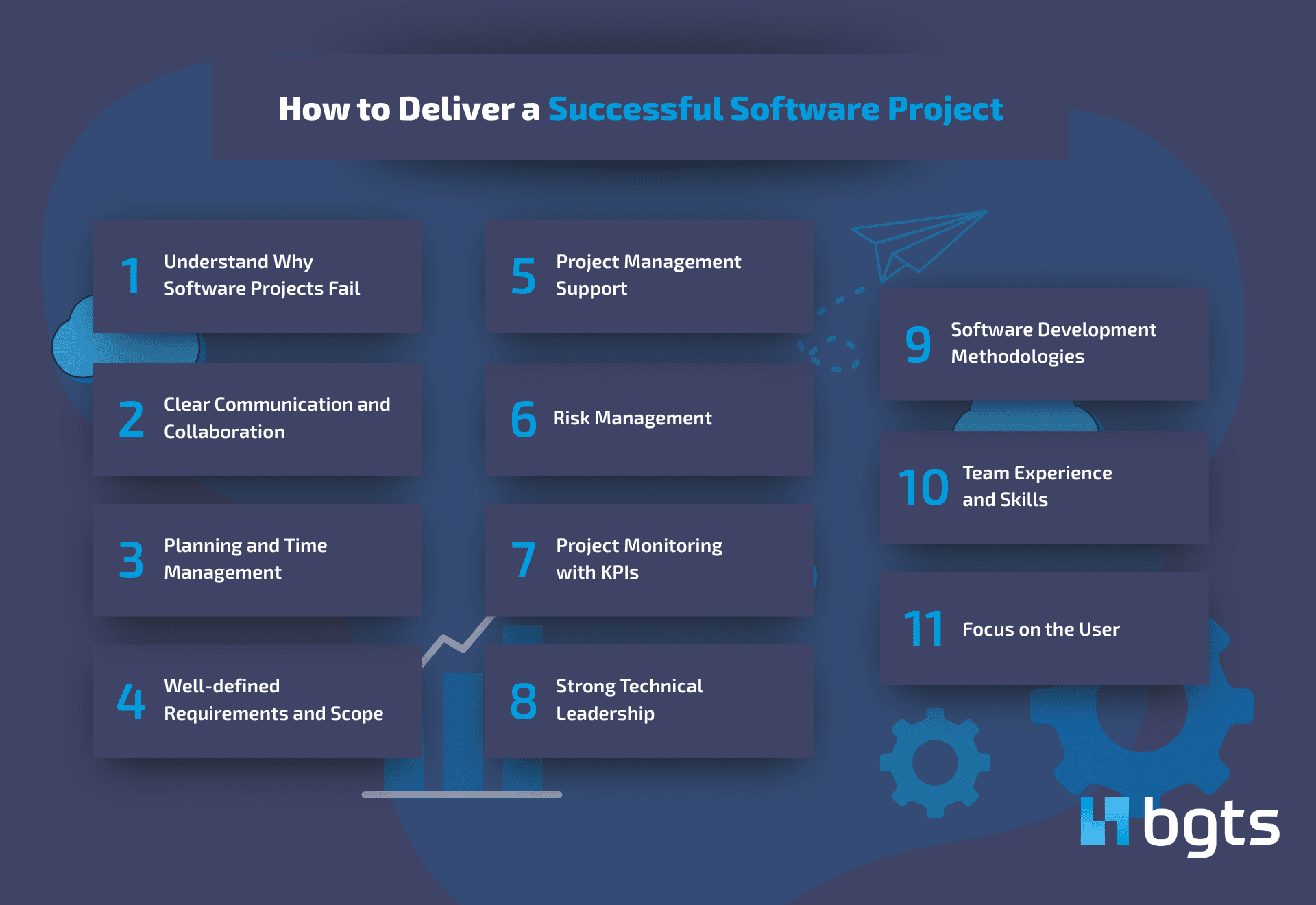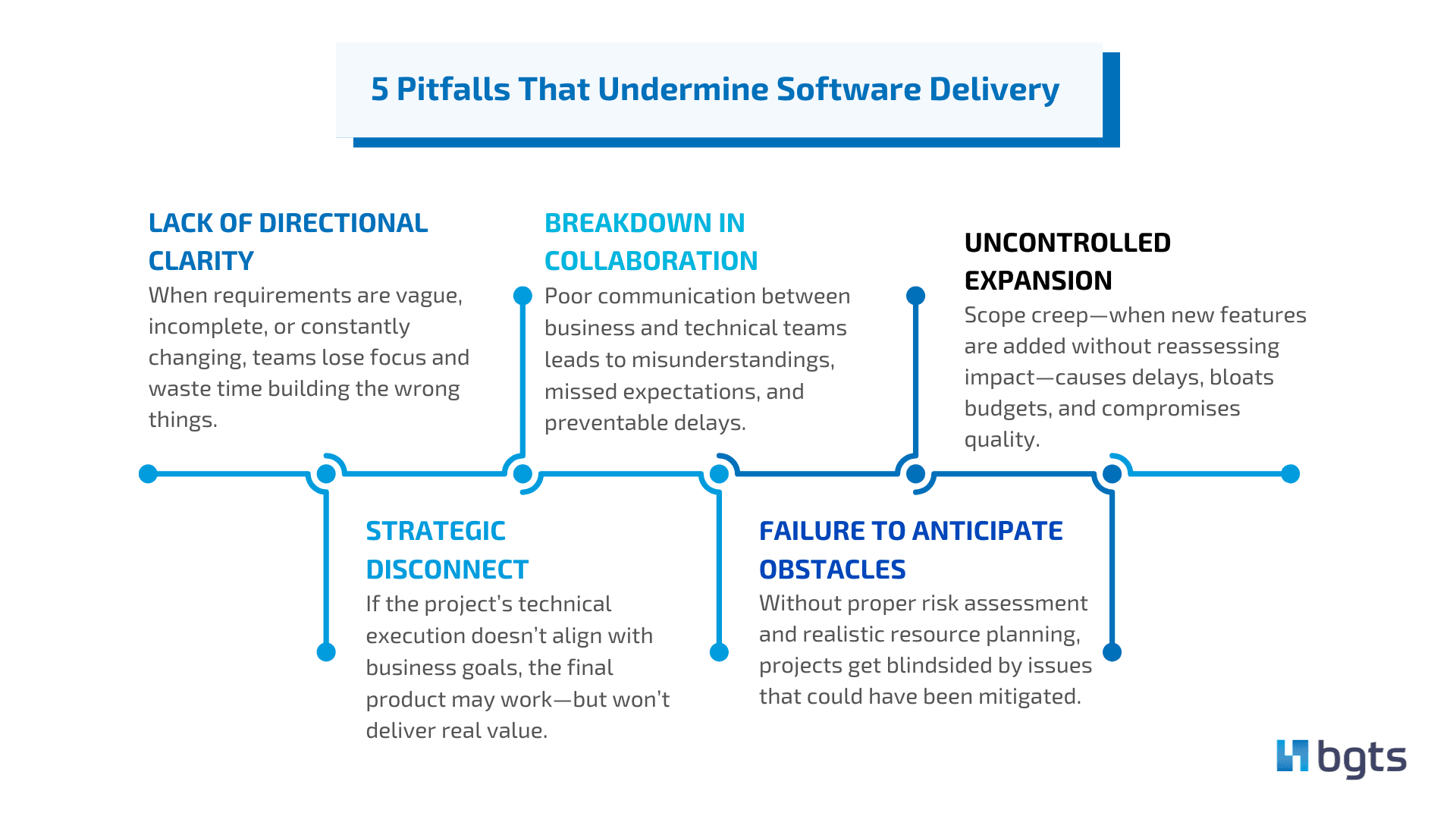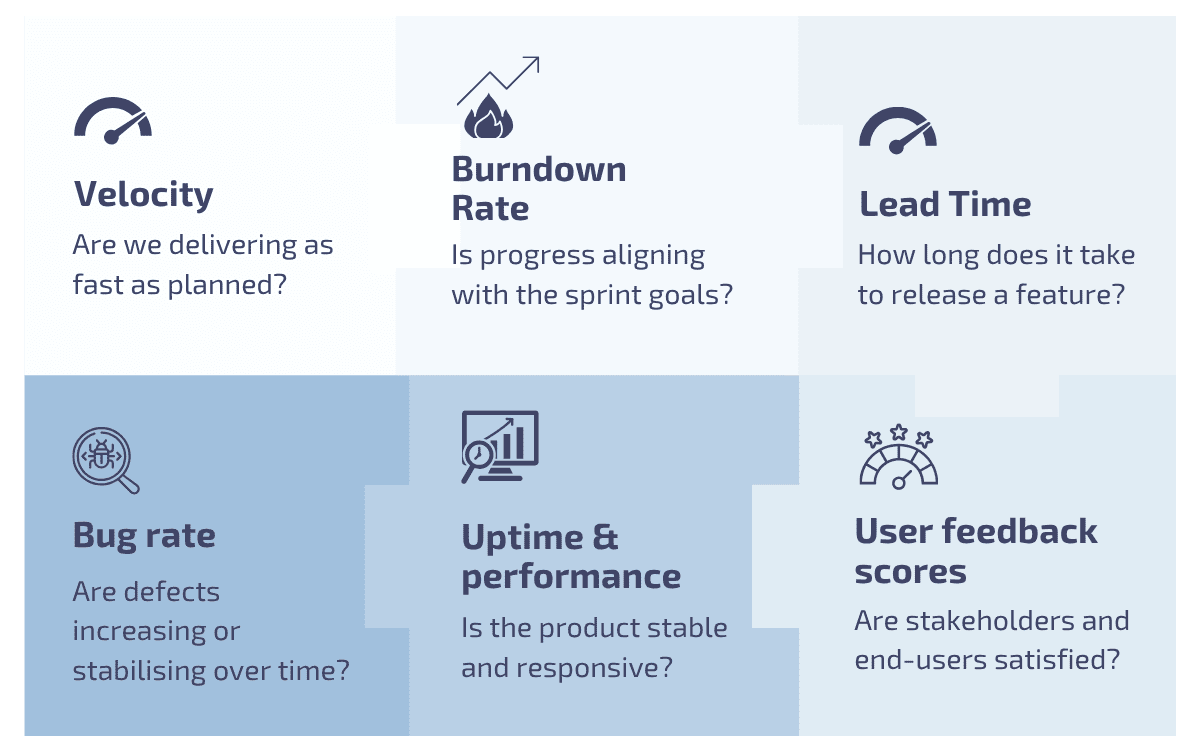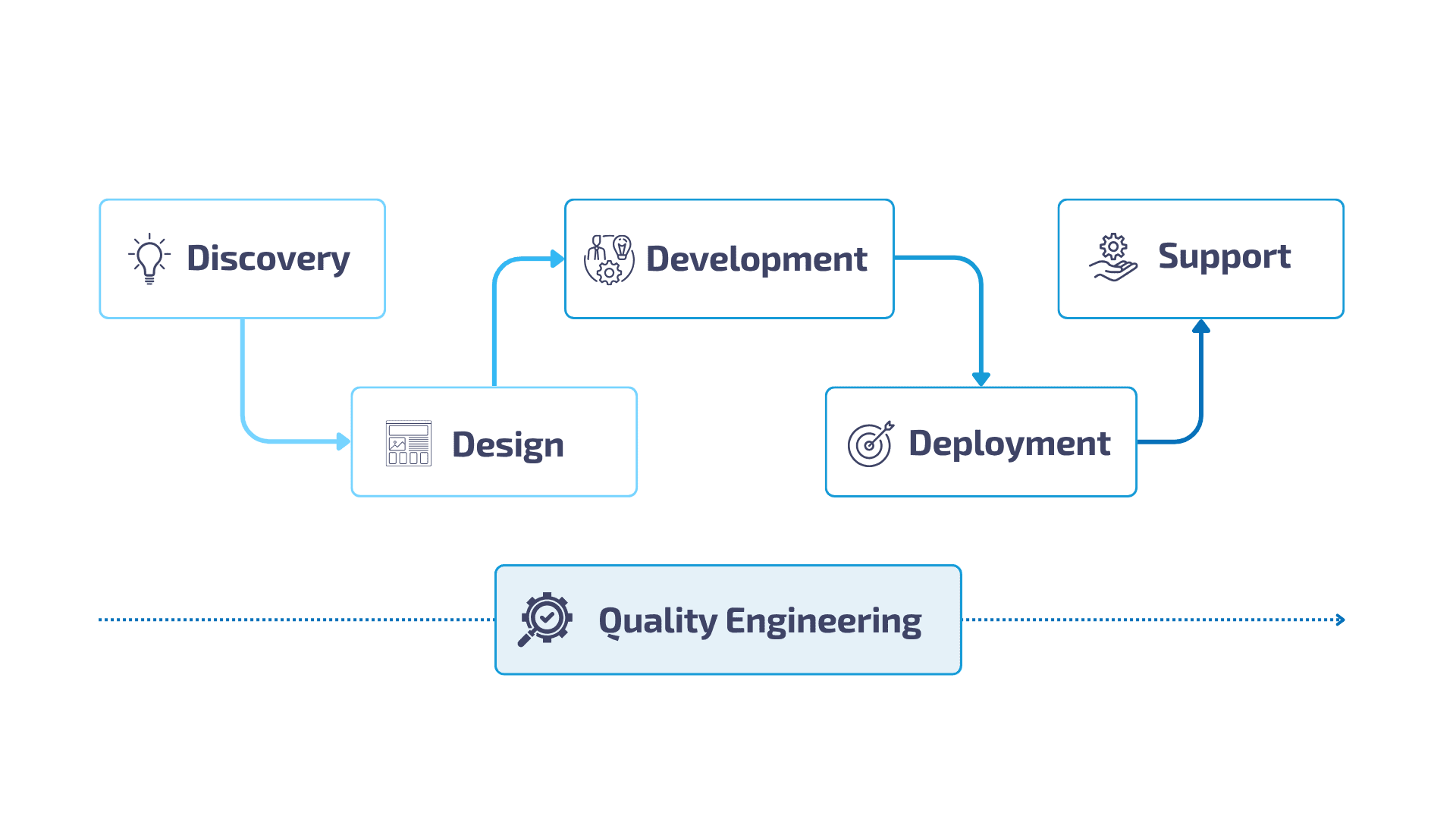Delivering a software project that truly works—for users, for stakeholders, and for the business—is never just about writing code. It’s about solving the right problem in the right way, with the right people and processes in place. Yet despite the investment of time and resources, many projects still fall short of expectations or fail entirely.
So, what separates success from failure? In this blog, we explore the 11 critical factors that consistently drive software project success—rooted in industry data, practical insight, and BGTS’s enterprise experience. Whether you’re planning a new solution or looking to improve delivery outcomes, these principles can help you navigate complexity with confidence.

11 Key Factors to Deliver a Successful Software Project
Understand Why Software Projects Fail
Software failure isn’t rare—it’s alarmingly common. According to 2024 industry research, 31.1% of software projects are cancelled before completion, while 52.7% exceed their original budgets by an average of 189%. Perhaps most strikingly, only 16.2% of projects are completed on time and within budget. These figures highlight the persistent challenges organisations face when trying to turn a concept into a successful, functioning solution.
So what’s going wrong?

5 Pitfalls that Undermine Software Delivery
The root causes are often not technical—they’re organisational and structural:
- Unclear or shifting requirements that leave teams without direction
- Poor communication across business and technical teams
- Misalignment between business goals and technical execution
- Inadequate risk planning and resource forecasting
- Scope creep without proper change control
These issues can undermine even the most talented teams and promising ideas. The most successful software projects aren’t those that avoid challenges entirely—but those that anticipate and mitigate them from the outset.
That’s why successful delivery starts with clarity, alignment, and structure—before a single line of code is written.
Clear Communication and Collaboration
Miscommunication is one of the most common (and costly) reasons software projects veer off track. When stakeholders, developers, and users aren’t on the same page, priorities shift, timelines blur, and quality suffers. According to recent studies, 57% of project failures are directly linked to poor communication.
Successful software delivery requires more than technical expertise—it demands a culture of collaboration. This means ensuring:
- Business stakeholders and development teams have a shared understanding of goals
- Project status is always visible and accessible
- Feedback loops are short, structured, and ongoing
- There’s a clear process for escalating blockers and making decisions
Whether it’s during requirement gathering, sprint planning, or user testing, communication must be continuous—not just scheduled. This ensures teams can adapt quickly, resolve issues early, and maintain focus on what matters most.
In the context of enterprise software, where multiple departments and vendors may be involved, establishing these communication practices isn’t optional—it’s essential. Without it, complexity multiplies and accountability disappears.
Planning and Time Management
Even the most innovative software idea can fail without a solid execution plan. Poor planning is one of the key reasons projects miss deadlines, go over budget, or fail to meet expectations. In enterprise environments, where dependencies are complex and stakeholder input is multi-layered, the margin for error is even smaller.
Effective planning starts with realistic scoping. That means breaking down the project into manageable phases, estimating time and effort accurately, and identifying critical paths early. But good planning doesn’t stop at the start—it requires continuous time management throughout the project.
Key practices that drive success include:
- Setting achievable milestones with clear ownership
- Prioritising features based on business impact and feasibility
- Accounting for buffer time to handle unexpected changes
- Reviewing progress regularly and adjusting timelines when needed
Time is not just a constraint—it’s a strategic resource. Managing it well ensures that your team stays focused, stakeholders stay aligned, and business value is delivered without unnecessary delay.
Well-defined Requirements and Scope
One of the most preventable causes of software project failure is starting with vague or evolving requirements. When the scope isn’t clearly defined, teams make assumptions, features creep in without evaluation, and the final product often misses the mark—either technically or strategically.
A successful project begins with well-documented, prioritised, and agreed-upon requirements. These are the foundations for design, development, and testing. But a good scope definition is not just about documentation—it’s about clarity of intent.
Key elements of strong requirement and scope definition include:
- Translating business goals into actionable, measurable outcomes
- Identifying user personas and use cases early in the process
- Prioritising must-haves vs nice-to-haves
- Establishing a change management process for evolving needs
Without this structure, scope creep becomes inevitable, timelines slip, and budgets swell. But with it, the entire team—developers, testers, designers, and stakeholders—can work toward a shared and stable objective.
Project Management Support
Behind every successful software project is strong, hands-on project management. Without it, even the best teams can lose focus, overlook dependencies, or fall out of sync. Good project management doesn’t just organise work—it aligns strategy, people, and progress.
The role of a project manager is to act as a bridge between stakeholders and the delivery team, ensuring that objectives are met, risks are flagged early, and everyone stays accountable. Managing a project well is important—but so is having the right systems to support it.
Choosing the Right Project Management Tools
Using robust project management tools is essential for visibility and collaboration. Platforms like Jira, or Azure DevOps allow teams to:
- Track tasks and sprints in real time
- Monitor progress against timelines and budgets
- Capture change requests and feedback efficiently
- Ensure transparency across distributed teams
For enterprise-scale projects, it’s not just about scheduling—it’s about governance. The right tools, combined with experienced oversight, help ensure that delivery stays on track, even in the face of complexity.
With project planning and governance in place, the next success factors focus on business analysis—translating business goals into actionable requirements, aligning technical execution with user needs, and ensuring that the end solution delivers real, measurable value.
Risk Management
Every software project carries risk—technical, operational, financial, or strategic. The difference between success and failure often comes down to how early and effectively those risks are identified and managed.
Too often, risks are addressed reactively—only after delays or issues have already occurred. A better approach is proactive risk management, where potential obstacles are anticipated from the outset and plans are in place to mitigate them.

4 Key Risk Management Practices
Key risk management practices include:
- Early identification of technical uncertainties, third-party dependencies, and compliance concerns
- Prioritisation of risks based on likelihood and impact
- Contingency planning, with backup strategies for critical path items
- Continuous reassessment as the project evolves
In large or high-stakes projects, even a small overlooked risk can escalate quickly. That’s why structured risk reviews, technical spike sessions, and regular retrospectives are essential—not optional.
Enterprise software delivery isn’t about avoiding risk altogether; it’s about having the confidence and systems to handle it when it emerges.
Project Monitoring with KPIs
If you can’t measure it, you can’t manage it. Many software projects drift off course not because of poor execution—but because no one is tracking the right indicators until it’s too late.

6 Project Monitoring KPIs
Monitoring a project’s health in real time is essential to delivering on time, on budget, and to specification. Key Performance Indicators (KPIs) offer early signals—helping teams course-correct before issues escalate.
Some critical KPIs in software delivery include:
- Velocity – Are we delivering as fast as planned?
- Burndown rate – Is progress aligning with the sprint goals?
- Lead time – How long does it take to turn a requirement into a working feature?
- Bug rate – Are defects increasing or stabilising over time?
- Uptime and performance – Is the product stable and responsive?
- User feedback scores – Are stakeholders and end-users satisfied?
These metrics should be reviewed consistently—not just during retrospectives or steering meetings. With the right dashboards and alerts, project stakeholders can make data-driven decisions instead of relying on assumptions.
Monitoring KPIs isn’t about micromanagement—it’s about keeping everyone focused on outcomes and ensuring delivery remains tied to business value.
Strong Technical Leadership
Behind every scalable, secure, and maintainable software solution is strong technical leadership. While project managers steer the process, it’s the technical leads and architects who define the foundation—the architecture, technology stack, and engineering standards that shape long-term success.
Strong technical leadership ensures:
- Sound architectural decisions that align with business goals
- Code quality and consistency through established development standards
- Scalability and extensibility, so the solution evolves with your needs
- Mentorship and technical oversight, ensuring junior developers stay aligned
Without this layer of expertise, teams risk technical debt, rework, or performance issues that surface only after launch—when fixes are far more costly.
In enterprise software projects, technical leadership isn’t just about writing good code—it’s about making strategic technology decisions that hold up under pressure, scale under growth, and integrate with complex systems.
Software Development Methodologies
The methodology you choose sets the rhythm of your entire project. Whether it’s Agile, Scrum, Kanban, or a hybrid approach, your delivery model must support transparency, adaptability, and velocity—especially in complex or evolving enterprise environments.
There’s no one-size-fits-all answer. The right methodology depends on:
- Project complexity and scope
- Team size and distribution
- Stakeholder involvement and review cadence
- Regulatory or compliance constraints
What matters most is not the label—but how effectively the methodology supports collaboration, feedback, and incremental delivery. Agile, for example, enables fast iterations and continuous refinement, while more structured approaches may suit fixed-scope or compliance-heavy projects.
The key is consistency and discipline. Even Agile fails without proper backlog management, sprint reviews, or clearly defined roles.
Ultimately, the best methodology is one that empowers your team to move forward with clarity—and gives stakeholders confidence at every stage.
Team Experience and Skills
No process or tool can compensate for a lack of capability. The success of a software project ultimately comes down to the people building it—their experience, skill sets, and ability to work as a cohesive unit.
Experienced teams bring more than just technical proficiency. They:
- Anticipate edge cases others overlook
- Choose the right tools and frameworks for the job
- Understand the balance between speed and sustainability
- Communicate effectively across disciplines
- Deliver with confidence under pressure
Enterprise-grade delivery demands a team that’s done it before—teams that can handle integrations, scalability, performance, and security without guesswork. That’s why it’s critical to evaluate not just individual resumes but the collective experience of the delivery team.
Successful outcomes are rarely a result of luck—they’re the product of capable people applying best practices with clarity and precision.
Focus on the User
A technically flawless solution can still fail—if it doesn’t work for the people using it.
Too often, enterprise software is built around internal processes or technical constraints, rather than actual user needs. But the most successful projects start with a simple question: What will make this valuable and usable for the end user?
Focusing on the user means:
- Involving users early—through interviews, journey mapping, or prototypes
- Prioritising usability alongside functionality
- Testing workflows with real users, not just internal stakeholders
- Iterating based on real-world feedback, not assumptions
Create with the User in Mind
At its core, software is a tool—and the people using it are the ultimate benchmark for success. The more intuitive, accessible, and aligned your product is with their daily needs, the higher the adoption, satisfaction, and long-term ROI.
In enterprise environments, where solutions often support multiple roles, departments, and workflows, user focus becomes even more critical. If the product doesn’t work for them—it doesn’t work at all.
How BGTS Turns Best Practices into Delivery: Our Development Process
While understanding the principles behind software project success is essential, the real differentiator lies in execution. At BGTS, we follow a structured, six-stage methodology designed to consistently deliver tailored, high-impact software solutions for enterprise clients.

Our process is built on clarity, adaptability, and performance—ensuring every project stays aligned with business goals from start to finish:
1. Discovery
We start by understanding your business inside and out—your goals, users, and challenges. Through stakeholder workshops and requirement analysis, we define a shared vision that sets the direction for everything that follows.
2. Design
Based on the discovery insights, we translate business needs into detailed workflows, wireframes, and architecture. Our UX/UI experts ensure the solution is not only functional but intuitive and easy to use.
3. Development
Using modern, scalable tech stacks, we build the application in iterative cycles. Features are delivered incrementally—ensuring alignment, transparency, and continuous progress throughout the project.
4. Deployment
Once the system is tested and approved, we deploy it into your environment with full operational readiness. This includes configuration, data migration, and any necessary integration with third-party tools.
5. Support
Post-launch, we provide ongoing technical support, maintenance, and performance monitoring. Our goal is long-term value—keeping your solution reliable, secure, and ready to evolve.
Quality Engineering
Quality assurance isn’t a single step—it’s embedded across the entire lifecycle. From design validation to regression and performance testing, we ensure quality is built in, not added later.
Ready to Deliver with Confidence?
Delivering successful software projects isn’t just about knowing what to do—it’s about having the right people, experience, and systems in place to do it well, every time.
With 30 years of experience, 1,100+ completed projects, and a proven track record with large enterprises, BGTS has built a delivery model that combines strategic clarity with technical excellence. Our team of 1200+ engineers and specialists brings deep domain expertise across industries and technologies.
What sets us apart is how we engage: our customer success teams and project managers all have a technical background. This allows us to bridge business and technology seamlessly—communicating with clarity, managing complexity, and always staying focused on what matters most to your organisation.
From discovery to delivery, BGTS doesn’t just build software. We build solutions that work—on day one and for years to come. Ready to move forward with clarity, confidence, and a team that delivers? Explore our Custom Software Development Services to see how we turn ideas into enterprise-ready solutions.




